Looking out from the observation deck, I watch a burnished parade of green-and-cream carriages file through the single-track, palm-lined corridor. The Eastern & Oriental Express, identified by the gilded lettering on every car and the rampant tiger logo above it, is a train to be admired from without as well as within. Lineside smallholders and schoolchildren have been doing just that, hands on hips and mouths slightly agape, ever since we eased across the causeway from high-rise, regimented Singapore into the jungles of Malaysia.
Belmond, doyen of luxury retro rail travel, is best known for its Venice Simplon-Orient-Express. But this timeless tropical environment, and the single, slender-gauge line laid through it at the turn of the 20th century, seems a far more evocative backdrop for its stately trains than the suburbs and industrial estates of 21st-century continental Europe. As embankment flora, bananas trump brambles every time.
My middle-category “state cabin” is three wooden corridors north of the observation car at the train’s rear and some 15 south of the defiantly functional state-railway diesel locomotive that hauls us. It is a bijou study in period opulence: royal blue and deep green velvet and silk, embroidered with dragons and orchids; cross-hatched marquetry. Illumination is warm and muted and, with a hint of old polished teak in the air, it even smells the part.
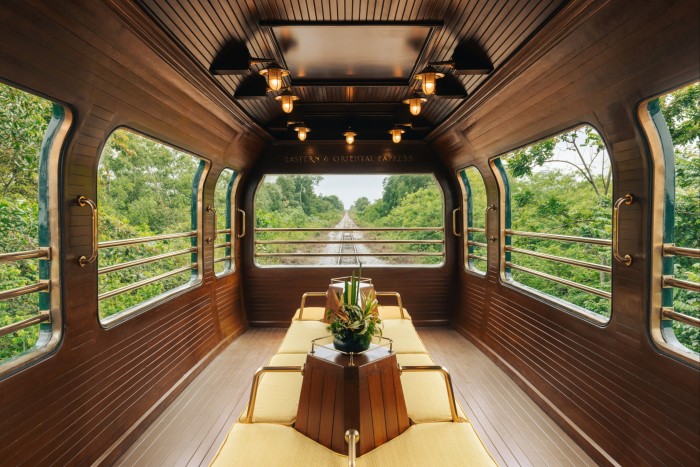
These experiences depend on curating an authentically redolent heritage and building a sense of elaborate occasion. Every boarding card, luggage tag and menu is a becoming amalgam of Art Deco typography and tropical Victoriana; the pop-up, cut-out cocktail brochure might double as a Wes Anderson graphic novelette. That heraldic tiger is stamped and embroidered into every burnished teapot, napkin and complimentary slipper, even embossed into the monolithic ice cube that chills your piano-bar Singapore sling.
This train, your senses keep telling you, has plied this route forever and a glorious day. Yet, in astonishing reality, it first saw service in New Zealand in 1971, a Wellington-Auckland sleeper that billed itself as “the fastest motel on wheels” and lasted a mere eight years, killed off by cheap flights.
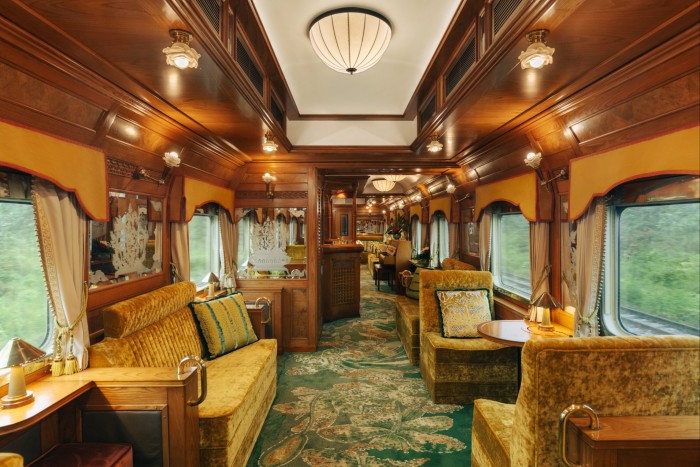
The origin of these carriages, and their remarkable metamorphosis, tells the story of overnight railway travel as it has unfolded in the post-steam era, from the last knockings of speed-focused practical transportation to its renaissance as a nostalgic indulgence, to be savoured at a ruminative pace. One imagines Somerset Maugham and Rudyard Kipling bumping down these corridors, but in fact the Eastern & Oriental Express didn’t even exist until 1993, after those redundant carriages were shipped to Asia, refurbished and set to work running between Singapore and Bangkok.
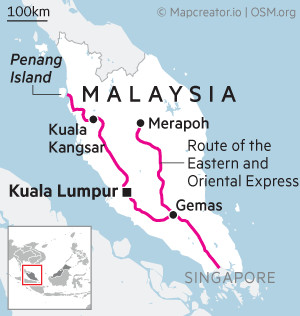
Services were suspended in 2020 as a result of pandemic and a four-year hiatus has allowed Belmond’s craftsmen to refresh and retrim the train throughout, in time for this year’s relaunch. Two seasonal three-night return itineraries between Singapore and Penang are now being offered, with hopes that the original through service up to Bangkok might soon return.
My air-conditioned compartment is long enough to encompass two curtain-swagged windows and an en suite shower and toilet — a universal facility on this train, though not aboard its storied trans-European counterpart. (The E&OE’s generous cabin dimensions — particularly those of the presidential suites that each occupy half a carriage — help explain why our enormous train is home to just 45 passengers. Yet for what it’s worth, and it’s worth quite a bit, this exclusivity is in very relative terms a bargain: on a per-night basis, the Venice Simplon-Orient-Express is more than three times as expensive.)
As I’m the sole occupant of a two-berther, and no longer in denial about my afternoon nap habit, my jaunty Sri Lankan steward agrees to leave one of the two plush armchairs permanently converted in beckoning bed mode, mattress plump and linen crisp. Nowhere but an upscale sleeper train can offer this deeply alluring combination of cosiness and grandeur, and it’s clear that only something pretty special will lure me from my capsule palace. As it transpires, each of the following three days is dense with pretty special somethings.
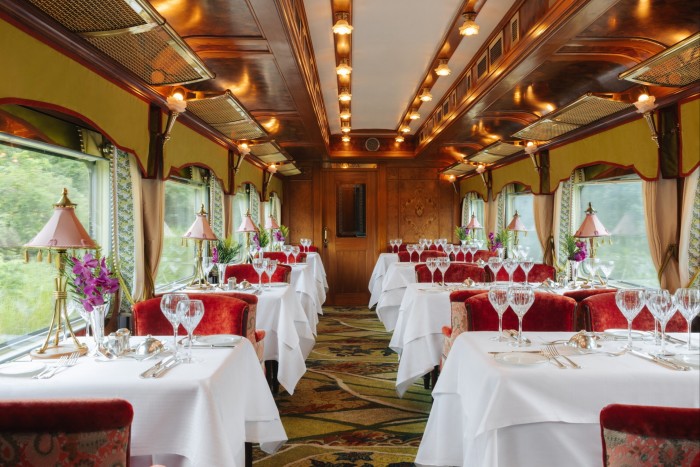
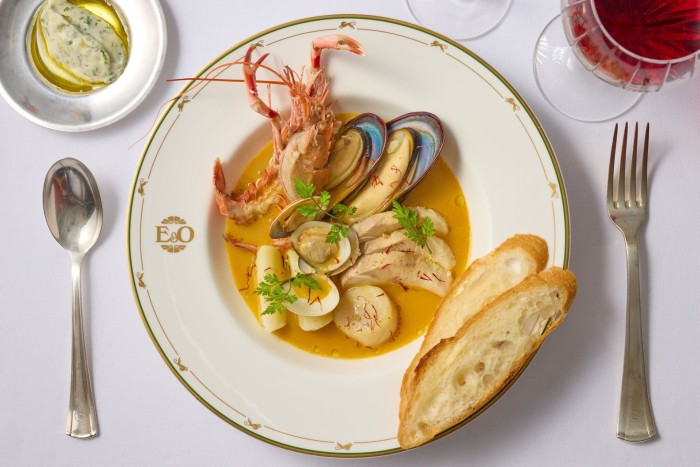
Many are hosted in the two dining cars, where superstar Taiwanese chef André Chiang and his team lay out sublime meals on starched damask, amid a small forest of chinking, winking crystal. “Spices are what trigger your sense of place,” Chiang announces before our inaugural dinner, “and on this trip I will offer spices that follow my own journey from Asia to France and back.” He doesn’t specify that this journey took in his rise to head chef of the three-Michelin-star Jardin des Sens in Montpellier, and has concluded with ownership of five garlanded restaurants across south-east Asia.
Kimchi niçoise with a champagne vinaigrette, udon galette, yam anglaise, sesame sauerkraut, laksa bouillabaisse — this is fusion at its most definitive, and by common passenger consent its finest. It is an enduring wonder to see such complex and intricately presented dishes laid before us, knowing they have been put together in a wobbling cupboard. How can you slow-braise beef cheeks for 16 hours on a train?
Every day begins with an expectant ritual. Tie back the curtains, crank up the blinds and behold a new world taking shape before that big blood orange rising from the horizon: misty paddy fields, spindly rubber trees, jacarandas coming into majestic mauve blossom, the slightly nagging preponderance of palm-oil plantations marching in file up those ochre hillsides. Families duck out from under colourful corrugated iron roofs, then set off for work three-up on mopeds. My steward arrives with a breakfast tray, another Euro-Asian melange of continental pastries and noodles in aromatic broth, before the train’s gracious announcer tells us that we will shortly be stopping for our morning excursion. “Please disembark from the piano bar,” she concludes, winningly.
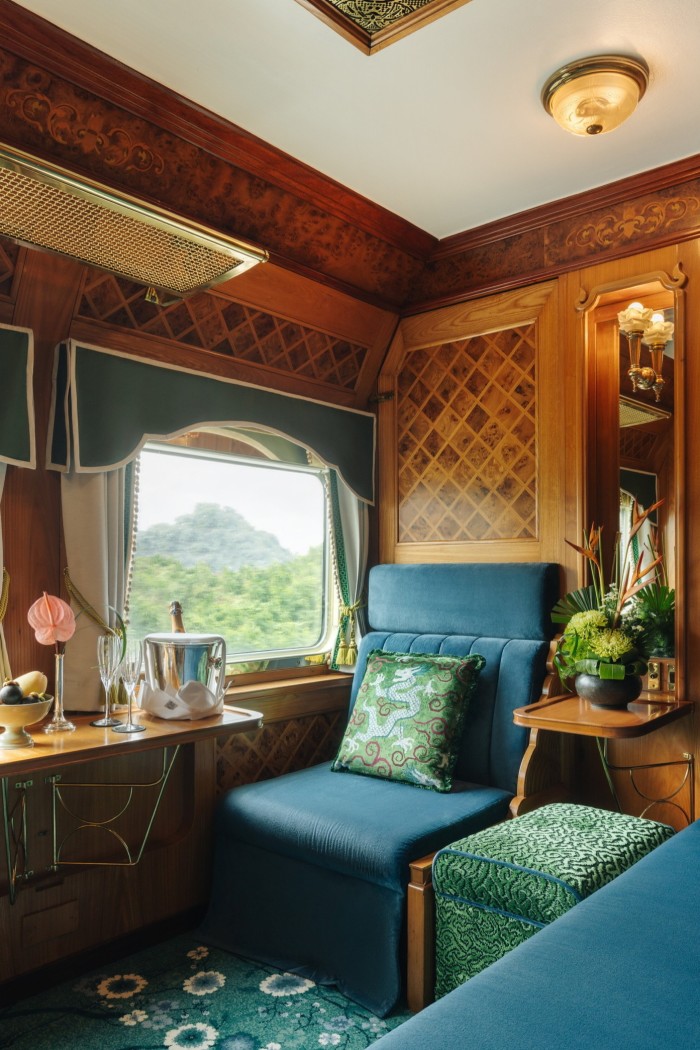
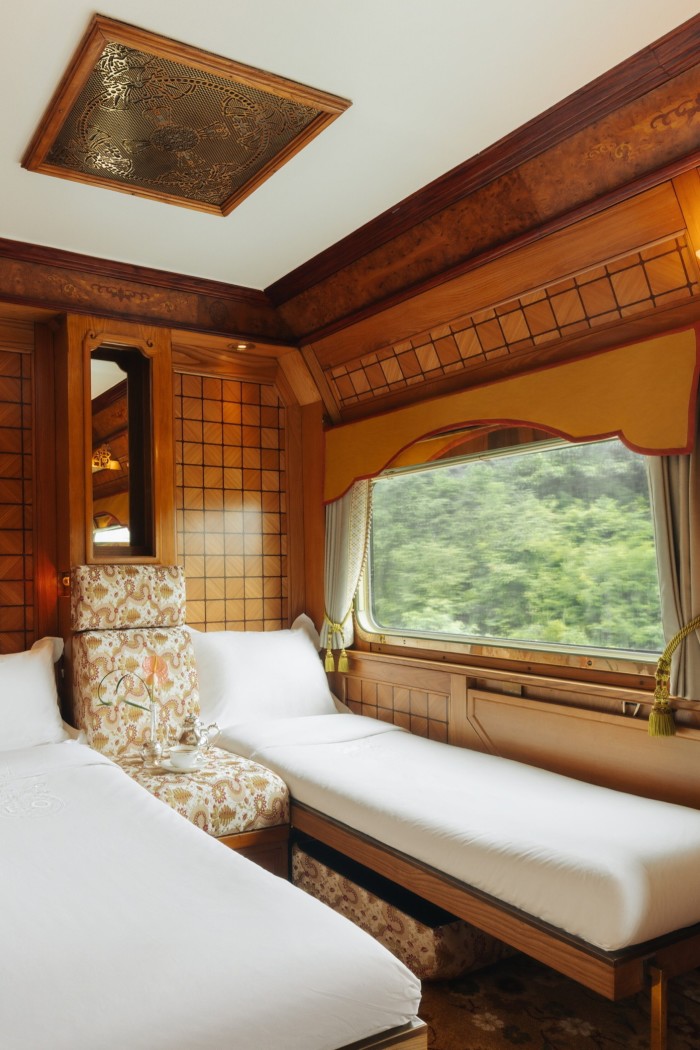
The crew need everyone off the train to primp and prepare, refashioning cabins into their daytime plumage. But beyond the practicalities, it’s good to be popped out of that golden bubble at least once a day, to underpin this experience with some contextual ballast by engaging with scenery and people you’ve only watched through the window.
At Merapoh, a lonely jungle halt in the Taman Negara national park, I pick the option of an e-bike ride to a pair of deep caves, gliding through soupy heat and rubber plantations to the foot of a towering limestone escarpment smothered in vegetation. Faithful to this trip’s painstaking sense of spectacle, we find the caverns’ deepest chambers magically illuminated by a profusion of lanterns. We emerge to find a cheese table laid out, an inevitable homage to diversity that memorably includes Sambal Gouda and a local Double Gloucester.
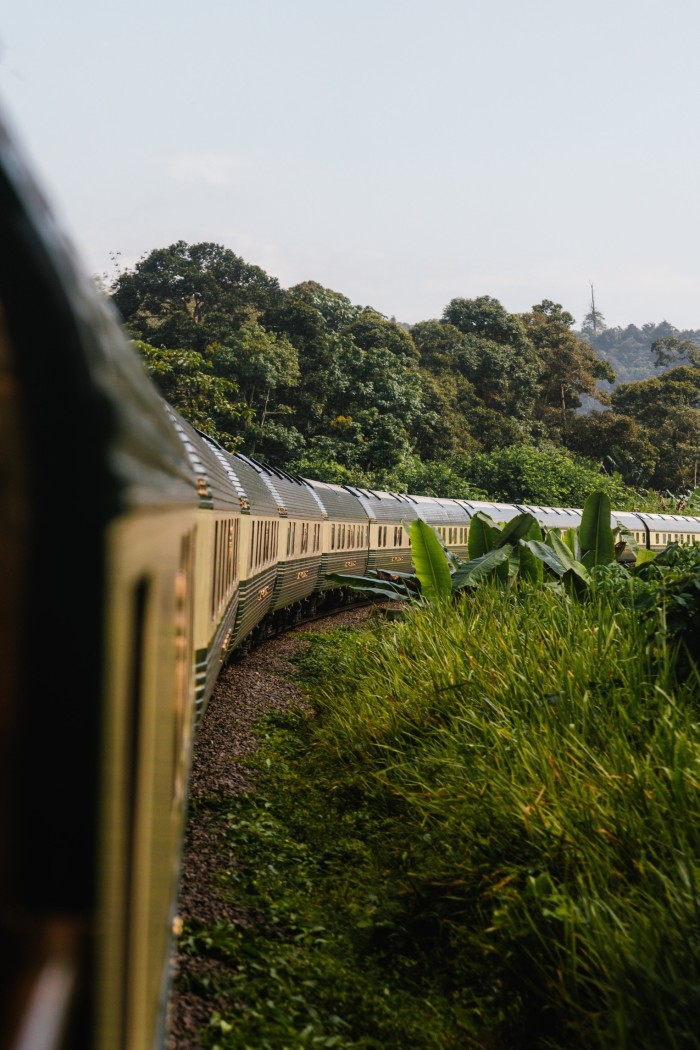
By way of extravagant contrast, the following morning sees me touring the clamorous streets of George Town, Penang island’s hyperactive capital, in a trishaw pedalled by an elderly Indian. Our three-hour ride through the torrid multicultural bustle takes in a Chinatown that spills out into the bay on stilts, brilliant white colonial clock towers and fire stations, and a bipolar Indian quarter: the Hindu half full of noise, gold temples and wafts of samosa, its Muslim counterpart entombed in mid-Ramadan silence.
There’s also a ride-by circuit of the Eastern & Oriental Hotel, an ivory behemoth whose association with our train extends no further than its name. Murmuring through his grey beard, my driver tells me it was opened in 1884 by the Armenian Sarkies brothers, serving as the template for the Raffles hotel they built three years later in Singapore. By noon it’s so brutally hot that moped riders wait for the lights to change in patches of shade. A ferry reunites us with the E&OE at Butterworth station, our northern terminus, where the crew stand ready with cool, damp towels.
There are grand luncheons that prevent me doing justice to the grand teas my steward delivers to my cabin a couple of hours later, petits fours topped with gold leaf on a silver tray. There’s a stop at Ipoh, where our water tanks are replenished, and we hop out to admire the dome-topped imperial facade of the only steam-age station that survives along our route.
Exploring the colonial avenues behind, I find another of those Victorian clock towers, this one commemorating James Birch, an overzealous British administrator who was murdered in his bath in 1875. But Birch’s bust has been removed, and the two streets that pass the tower are now named in honour of his executed assassins. Malaysia’s sometimes difficult relationship with its history shadows our journey. The single-track line to Merapoh was torn up by Japanese occupiers in the war, and relaid on the notorious Burma Railway.
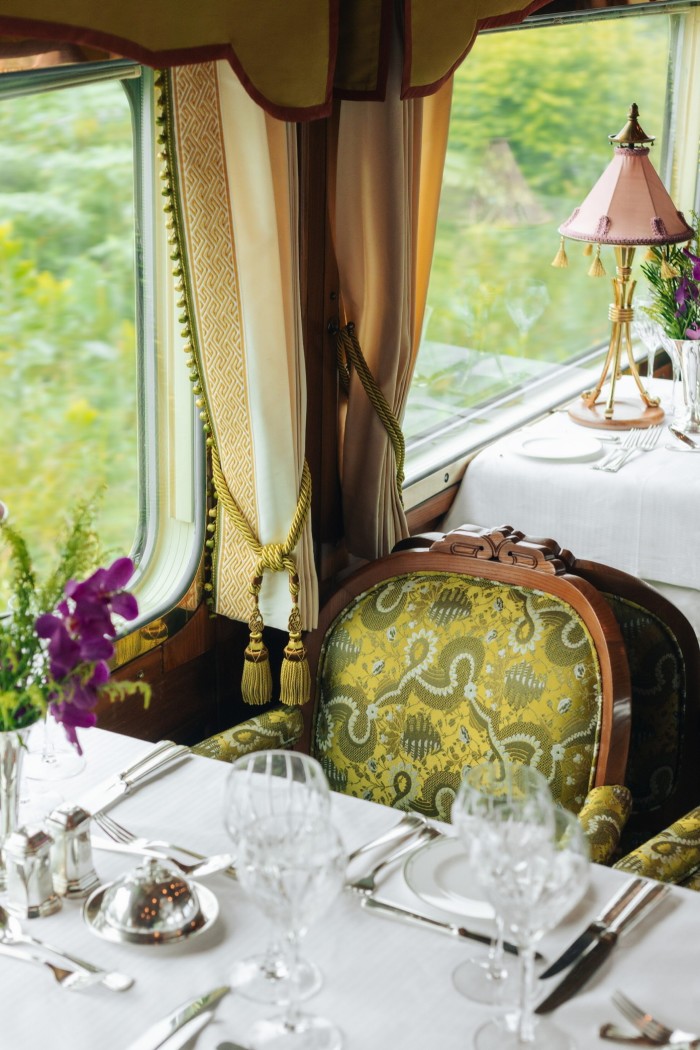
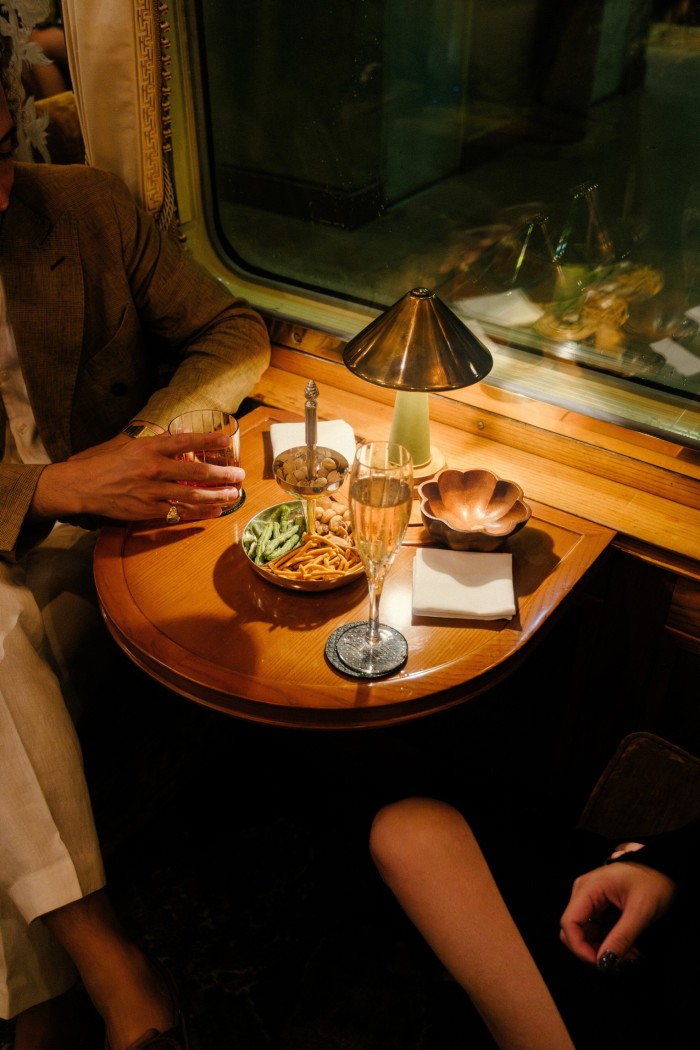
And from sunset onwards, there is much convivial glitz. As the E&OE’s general manager Valentin Waldman tells me over cocktails one evening, his passengers fall into two camps — those quietly absorbed in the trip of a lifetime, and the more casually gregarious bucket-listers who are here for that upscale, retro party-on-wheels vibe. If you don’t like dressing for dinner, or having card tricks performed in your face while eating it, this may not be the trip for you.
Courtesy of its eponymous features, the piano bar sees most of the action. Cocktails, pre- and post-dinner, are enlivened by an ever-changing roster of magicians and musicians, most notably the glamorous vocalist we stop to pick up in the dusty middle of nowhere late one afternoon, trotting excitedly past my window in very high heels, bow-tied accompanist in tow. Nanyang jazz blends into “Moon River”, accompanied by atmospheric clatters of tropical rain on the black windows. Soft lighting and gold velvet encourage a companionable ambience, and sheer proximity enforces it. There’s an irresistible sense of theatre, as if we all have a part to play in some iconic travelling production. Perhaps, someone suggests, they’ll invite us back as extras in a new season of White Lotus.
“You may feel a small movement while the train realigns itself,” the announcer gently advises us every evening. On a route that’s largely single track, and features a few dead ends, a lot of things go bump in the night as we decouple and shunt. But I’m always grateful to be joggled awake by such venerable manoeuvrings, glad for every reminder of where I am and what I’m doing, and aware I will soon be rocked back to sleep.
Winding up the blinds on the final morning, I’m greeted by Singapore’s glass towers and metal trees. We come to rest at a four-square concrete station and the spell is broken. Three nights, I decide, is perhaps the sweet spot for an experience like this. Anything less would be a crying shame; too many more and the idiosyncrasies might lose a little of their charm. As it is, a part of me still starts every day with a jiggly shower, and ends it bouncing down dimly lit panelled corridors, bound for that open observation deck where the wind is warm and a pair of moonlit rails slide away between the jungle shadows.
Details
Tim Moore was a guest of Belmond (belmond.com). Its three-night “Wild Malaysia” itinerary starts at £3,042 per person and includes all meals, a selection of alcoholic and non-alcoholic drinks, onboard entertainment and off-train activities in the Taman Negara National Park and Penang. Trains depart Woodlands station in Singapore on Mondays at 3pm, from March until October
Find out about our latest stories first — follow FT Weekend on Instagram and X, and subscribe to our podcast Life & Art wherever you listen

